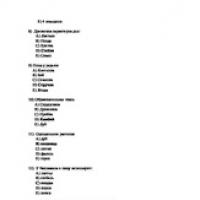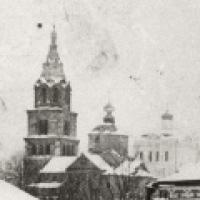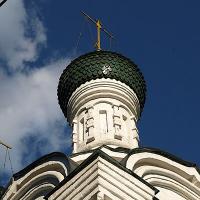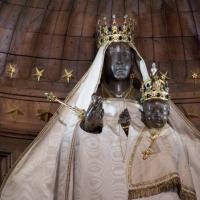Tests on the history of ancient Rus'. Test “Rus in the 9th – early 11th centuries.” history test (grade 10) on the topic Thematic tests: the first Russian princes
"The First Russian Princes".
1) Procopius of Caesarea; 2) Nestor;
3) Tacitus; 4) Konstantin Porphyrogenitus.
2. The churchyard is
1) place of collection of tribute; 2) place of trade;
3) collection of tribute.
3.In 945, the Drevlyans rebelled and killed:
1) Oleg; 2) Igor; v3 Vladimir.
4. The reign of which prince was marked by the baptism of Rus':1) Vladimir; 2) Oleg; 3) Svyatoslav 4) Olga
5. Who said before the campaign “I’m coming to you”:
1) Svyatoslav; 2) Oleg; 3) Igor.
6. To what century does the birth of statehood among the Eastern Slavs date back?
1.X – 11th centuries 2.IX – 10th centuries
3. XI – XII centuries. 4. VI – VII centuries.
7.The prerequisites for the formation of the Old Russian state include
1) baptism of Rus' 2) acceptance of Russian truth
3) the great migration of peoples
4) the need for organized resistance to external enemies
8.What century does the reign of Vladimir Monomakh date back to?
1) 9th century 2) X century. 3) XII century. 4) XIII century.
9. Read an excerpt from the ancient Russian chronicle and indicate what event is being discussed.“Why are we destroying the Russian land, bringing quarrels upon ourselves? And the Polovtsians are plundering our land and rejoicing that we are torn apart by internecine wars. From now on, let us unite wholeheartedly and protect the Russian land and let everyone own their homeland.” And on that they kissed the cross: “If now someone encroaches on someone, against him is an honorable cross and the whole Russian land.”
1) congress of princes in Lyubech
2) about the campaign against the Polovtsians
3) about the decision of the Stoglavo Cathedral
4) about the baptism of Rus'
"The first Russian princes".
I I option.
1. The oldest Russian chronicle was called
1) “Zadonshchina” 2) “The Tale of the Destruction of the Russian Land” 3) “The Tale of Igor’s Campaign”
4) “The Tale of Bygone Years”
2. Oleg’s conquest in Kyiv:
1) 862; 2) 882; 3) 912.
3. Oleg’s campaign against Constantinople:
1) 880; 2) 907; 3) 941.
4. What event happened in 882?
1) calling the Varangians to reign
2) death of Prince Igor
3) formation of the Old Russian state
4) Askold and Dir’s campaign against Constantinople
5.Which countries and lands did Prince Svyatoslav travel to?
1)Poland, Sweden, Denmark
2) Lands of the Cumans, Hungary, Wallachia
3)Volzhs. Bulgaria, Khazaria, Dunaisk. Bulgaria
4) Crimea, Asia Minor, Greece
6) Who was the last prince under whom the unity of Rus' was preserved?
1) Vladimir Monomakh 2) Yaroslav the Mudry
3) Mstislav the Great 4) Svyatopolk the Accursed
7) What were the consequences of the baptism of Rus'?
A) to the attempts of the Byzantine emperor to subjugate Rus' by force
B) to intensify the rivalry of Russian princes for the right to appoint a metropolitan
C) to the development of culture, education
D) to establish the power of the Norman Rurik dynasty
D) to strengthen the international position of Rus'
E) to strengthen the power of ancient Russian princes
1) AVE 2) BGD 3) VDE 4) BVD
8. When Rus' was baptized:
1) 980; 2) 988; 3) 990.
9.Which of the following happened during Olga’s reign
1) Rus' adopted Christianity
2) The Tale of Bygone Years was compiled
3) Lessons and churchyards installed
4)) Victory over the Pechenegs was achieved
10. Establish the chronological sequence of the reign of the princes:
A) Yaroslav the Wise B) Igor
B) Vladimir Red Sun D) Oleg
Formation of the Old Russian State
1. Eastern Slavs belong to the language family:
A) Finno-Ugric;
B) Iberian-Caucasian;
B) Indo-European;
2. Territory of settlement of East Slavic tribal unions inVI - IXfor centuries it has extended to:
A) West Siberian Plain;
B) East European Plain;
B) northern coast of the Black Sea;
3. The formation of a state among the Eastern Slavs occurs as a result of:
A) the decomposition of the tribal system and the emergence of classes;
B) callings of the Varangian princes;
B) agreements between the princes of East Slavic tribal unions
4. The formation of the Old Russian state occurs in:
A) VI century AD;
B) IX century AD;
IN) IX century BC;
5. The unification of the Eastern Slavs occurs around:
A) tribal union of glades;
B) tribal union of the Drevlyans;
B) tribal union of Polotsk residents;
6. The central part of the ancient Russian city was called:
A) the Kremlin;
B) child;
B) settlement;
7. Religion of the Eastern Slavs inVI - IX centuries was:
A) Christianity;
B) Catholicism;
B) paganism;
8. The date of formation of the state of Kievan Rus is considered to be:
A) 862;
B) 882;
B) 988;
9. The name of the dynasty of Kyiv princes was given by:
A) Rurik;
B) Oleg;
B) Cue;
10 The patron saint of cattle breeding among the pagan Slavs was God:
A) Veles;
B) Svarog;
B) Perun;
1. The main occupation of the Eastern Slavs was….
2. The capital of the Old Russian state was the city….
3. The most important trade routes of Ancient Rus' were….
4. The collection of tribute in Ancient Rus' was called....
5. Alexander the Great of Eastern Europe is called….
Old Russian state in IX – XII centuries
(closed form)
1. The most important political and trade ally of Kievan Rus inIX V. was:
A) Volga Bulgaria;
B) Byzantium;
B) Khazar Kaganate;
A) boyars;
B) slaves;
B) procurement;
3. The state religion of Kievan Rus at the endXcentury becomes:
A) paganism;
B) Christianity;
B) Catholicism;
4. The first city to be baptized was:
a) Novgorod;
B) Kyiv;
B) Iskorosten;
5. The first uprising mentioned in the chronicle took place in the lands:
A) glades;
B) Drevlyans;
B) Ilmen Slovenes;
6. The international position of Kievan Rus was strengthened with the help of dynastic marriages:
A) Prince VladimirI;
B) Prince Vladimir Monomakh;
B) Prince Yaroslav the Wise;
7. The Lyubech Congress of Russian Princes (1097) decided:
A) about organizing a campaign against the Polovtsians;
b) each to own his fatherland and protect the Russian land together;
C) on the procedure for replacing the Kyiv throne;
8. The first legal code in Rus' was:
A) “Russian Truth”;
B) “The Yaroslavich Truth”;
B) “Russian Law”;
9. The main military opponents of Russian squads inX V. were:
A) Cumans;
B) Pechenegs;
B) Tatro-Mongols;
10. The organizer of the campaign of the Russian princes against the Polovtsians in 1111 was:
A) Vladimir Monomakh;
B) Yuri Dolgoruky;
B) Andrey Bogolyubsky;
(open form)
1. The Baptism of Rus' takes place in ... the year by Prince ....
2. Leadership of the Russian Orthodox Church inXI V. carried out….
3. The Kiev prince Svyatoslav Igorevich intended to move the capital of the ancient Russian state to the city ....
4. Which Russian prince was nicknamed “The Accursed” and why?
5. The Kiev state reached its highest power under the prince ... in ... years.
Russian lands during the period of feudal fragmentation
(closed form)
1. The period of feudal fragmentation lasted in Rus':
a) with XI By XIII centuries;
b) with XII By XV centuries;
c) with X By XIV cc;
2. The Moscow principality arose:
A) in 1147;
B) in the second halfXIII century;
B) with the collapse of Kievan Rus in 1132;
3. The main military opponents of the Russian lands inXIII V. were:
A) Swedish feudal lords and German knights;
B) Polovtsy;
B) Tatar-Mongols;
4. The Battle of Lake Peipus (Battle of the Ice) took place in:
A) 1240;
B) in 1242;
B) in 1223;
5. The main occupation of the Mongols inXIIIV. was:
A)nomadic pastoralism;
b)irrigation agriculture;
V)arable farming;
6. Batu's campaign against Rus' took place:
A)in 1327;
b)in 1237-1241;
V)in 1480;
7. The Tatar-Mongol yoke in Rus' existed:
A)from 1237 to 1480;
b)from 1223 to 1380;
V)from 1243 to 1480;
8. The seniority of Russian princes inXIII- XVfor centuries it was determined:
A)age;
b)a label for reign issued by the Golden Horde Khan;
V)by the decision of the Congress of Russian Princes;
9. The Battle of Kulikovo Field took place:
A)in 1223;
b)in 1380;
V)in 1480;
10. The Golden Horde yoke ended for Rus':
A)Battle of Kalka;
b)Battle of Kulikovo;
V)standing on the Ugra;
(open form)
1. Feudal fragmentation is….
2. The main economic units during the period of feudal fragmentation were: ....
3. Baskaki are...
5. Moscow becomes the religious center of Russian lands in ... year in connection with ... .
6. The first Moscow prince Daniil was the son of...
Formation of the Russian unified state
(closed form)
1. The founder of the dynasty of Moscow princes was:
A) Daniil Alexandrovich;
B) Alexander Nevsky;
B) Ivan Kalita;
2. Dmitry Donskoy owned:
A) Galicia - Volyn principality;
B) the Moscow Principality;
C) territories along the Don River;
3. On the Kulikovo field, Russian soldiers fought with:
A) Polish gentlemen;
B) Tatar-Mongols;
B) German knights;
4. He was the first to accept the title of “Sovereign of All Rus'”:
A) Vasily the Dark;
B) Ivan the Terrible;
B) Ivan III;
5. Correlate the years of reign:
A) Ivan III 1) 1505 - 1533
B) Yaroslav the Wise 2) 1462 -1505
B) Vasily III 3) 1015 – 1054
6. The final annexation of Novgorod to Moscow took place in:
A) 1410;
B) 1478;
B) 1521;
7. The coat of arms with a double-headed eagle appeared as the official symbol of the Russian state during:
A) Ivan III;
B) Ivan Krasny;
B) Dmitry Donskoy;
8. Who was the first of the Russian rulers to be crowned king:
A) Ivan the Terrible;
B) Ivan III;
B) Dmitry Donskoy
9. The beginning of the enslavement of the Russian peasantry was laid:
A) Code of Law of 1497;
B) a provision limiting the right of peasant transition from
one owner to another a week before and a week after St. George's Day;
c) the decree “On serfdom”;
10. Under Ivan the Terrible, the following was introduced:
A) oprichnina
B) localism;
C) cancellation of St. George's Day;
(open form)
1.Name the factors that contributed to the rise of Moscow.
2. Name the reasons that contributed to the final overthrow of the Golden Horde yoke.
3. The formation of the Russian unified state takes place in ... centuries.
4. The methods of annexing Russian lands to the Moscow Principality were: ....
5.The main forms of feudal land tenure inXV – XVI centuries were: …
Test 5
Moscow kingdom
(closed form)
1.The dominant form of land tenure inXVI century was:
a) peasant plowing;
b) boyar estate;
c) noble estate;
2. What territories were annexed to Russia during the reign of IvanIV:
A) Volga region;
B) Western Siberia;
To Crimea;
3. Years of the oprichnina:
A) 1570 – 1575;
B) 1551 – 1562;
B) 1565 –1572;
4. During the oprichnina, the territory of the country was divided into:
A) counties and provinces;
B) zemshchina and boyars;
B) oprichnina and zemshchina;
5. Unofficial government under IvanIV called:
A) Seven Boyars;
B) Boyar Duma;
B) Elected Rada;
6. The “lesson summers” established in 1597 introduced:
A) localism;
B) punishment of state criminals;
C) a five-year search period for fugitive peasants;
D) ban on peasant march on St. George’s Day;
D) there is no correct answer.
7. The Livonian War had as its goal:
A) conquest of the Baltic coast and access to the Baltic Sea;
B) destruction of the Catholic Livonian Order;
C) the defeat of the Kazan and Astrakhan khanates;
8. The Livonian War ended:
A) defeat of Russia;
B) the victory of Russia and the annexation of new territories;
C) a mutually beneficial truce between the warring parties;
(open form)
1. Military reform in the middleXVIV. was...
2. The essence of the oprichnina was...
3. The results of the oprichnina were...
3. The years of the reign of Ivan the Terrible...
5. Years of the Livonian War
Russia at the turn XVI – XVII centuries Time of Troubles
(closed form)
1. Serfdom is:
a) a form of non-economic (legislated) dependence of the peasant on the feudal lord - the owner of the land;
b) a legally formalized regime for the functioning of military fortifications - fortresses;
c) the right of peasants to land;
2. The fall of the Rurik dynasty led to the Russian throne:
A) False Dmitry I;
B) boyar Tsar Vasily Shuisky;
B) Boris Godunov;
3. The main forms of peasant protest inXVI – XVII centuries were:
A) mass strikes;
B) refusal to go to corvee;
B) peasant uprisings;
4. The appearance of False DmitryIwas due to:
a) rumors about the miraculous salvation of the legitimate heir to the Russian throne - Tsarevich Dmitry;
b) the arrival of the Polish ambassador to Moscow;
c) the election of False Dmitry to reign by the Zemsky Sobor;
5. False Dmitry Irules in Moscow:
A) in 1602 -1610;
B) was not allowed into Moscow at all;
B) in 1605 – 1606;
6. Vasily Shuisky came to power after:
A) Boris Godunov;
B) False Dmitry I;
B) False Dmitry II;
7. Which historical figure was nicknamed the “Tushino thief”:
A) False Dmitry I;
B) False Dmitry II;
B) Cossack Tushin;
8. The heroes of the liberation of Moscow from foreign invaders, to whom grateful Russia erected the first sculptural monument in Moscow, were:
A) peasant Ivan Susanin;
B) Kozma Minin and Dmitry Pozharsky;
B) nobleman Lyapunov;
9. The accession of the Romanovs occurred due to:
A) decisions of the Zemsky Sobor;
B) family high birth and belonging to the Rurik dynasty;
C) outstanding achievements in the fight against the Polish-Swedish intervention;
10. The first Romanov on the Russian throne was:
A) Alexey Fedorovich;
B) Mikhail Fedorovich;
B) Alexey Mikhailovich;
(open form)
1. The causes of the unrest in Russia at the turnXVI – XVII centuries were: … .
2. The years of the reign of Vasily Shuisky... .
3. The years of the reign of Boris Godunov….
4. Name the main stages of the enslavement of peasants.
5. What candidates for the Russian throne were considered by the Zemsky Sobor in 1613?
Correct answer
1). Indicate the socio-political system that prevailed among the ancient Slavs before the calling of the Varangians:
A). Military democracy +
B). Theocracy
IN). Oligarchy
2). The largest centers of settlement of East Slavic tribal unions were:
A). The Urals and steppes of southern Eurasia
B). The upper reaches of the Dnieper and the area of Lake Ilmen +
IN). Lands of Bryansk and Polesie
3). How is the way of life of the ancient Slavs characterized?VI- Xcenturies?
A). Matriarchal
B). Gender didn't matter, the high priests had all the power
IN). Patriarchal +
4). The ancestor of the Slavic peoples, according to biblical legends, is:
A). Japheth +
5). According to legend, Rurik's grandfather was:
B). Gostomysl +
6). The legendary calling of the Varangians dates back to:
7). After the beginning of the reign of Rurik, the Varangians formed the elite layer of society in Veliky Novgorod. Which of the following played this role in VII- XIcenturies?
B). Princely squad +
IN). Council of Elders
8). Who, according to the chronicle tradition, was Prince Oleg the Prophet related to Rurik?
A). Druzhinnik
IN). Tribesman +
9). The unification of Novgorod and Kyiv took place in:
10). What was the name of the main trade artery that passed through the territory of the East European Plain inVII - XIIcenturies?
A). The Great Silk Road
B). The path from the Varangians to the Greeks +
IN). Rose line
eleven). In what year did the event depicted in the picture take place?
Test. 12). Indicate the work and its author that describes the life and deeds of the main character in the picture:
A). “Song of the Prophetic Oleg”, A. S. Pushkin +
B). “Prince Silver”, A.K. Tolstoy
IN). “Song about the merchant Kalashnikov”, M. Yu. Lermontov
13). The concepts “pogost”, “lesson” and “polyudye” refer to:
A). Penitentiary system
B). Tax system +
IN). Squad management
14). Which tribal union opposed the double collection of taxes on the initiative of Prince Igor?
A). Mordva
B). Ilmenskie Slovenes
IN). Drevlyans +
15). Trade agreement between Prince Igor and Byzantium:
A). Restricted the privileges of Russian merchants under the previous agreement +
B). In addition to the trade union, it provided for a political union
IN). Reinforced the provisions of the agreement concluded by Prince Oleg
16). Princess Olga rules:
A). 969-971
B). 945-957 +
IN). 913-945
17). Who was Princess Olga related to Prince Igor?
A). Wife +
B). Mother
IN). Sister
18). The famous appeal “I’m coming to you” was used by:
A). Prince Oleg
B). Prince Igor
IN). Prince Svyatoslav +
19). Which state did Prince Svyatoslav defeat during his campaigns?
A). Byzantine Empire
B). Poland
IN). Khazar Khaganate +
20). During the reign of Svyatoslav Igorevich, the following were under the rule of Kyiv:
A). Vyatichi +
B). Duleby
IN). Dregovichi
21). During the campaigns of Prince Svyatoslav in 965, the Old Russian state expanded its territories due to:
B). Upper Volga
IN). Taman Peninsula +
22). Prince Svyatoslav wanted to move the capital to:
A). Korsun
B). Tmutarakan
IN). Pereyaslavets-on-Danube +
23). What tribal union of nomads began to actively oppose Ancient Rus' during the reign of Svyatoslav?
A). Pechenegs +
B). Cumans
24). Returning from the war with Byzantium in Bulgaria in 971, Prince Svyatoslav:
A). Captured Crimea
B). Was killed +
IN). Started a war against Hungary
25). In what city did Vladimir Svyatoslavich reign at the time of his father’s death?
B). Ladoga
IN). Novgorod +
26). During the reign of Yaropolk Svyatoslavich in Kyiv, external contacts were actively carried out with:
A). Papal throne
B). Kingdom of the Franks
IN). Holy Roman Empire +
27). The brother of Vladimir and Yaropolk, Oleg Svyatoslavich, was a prince:
A). Vyatichi
B). Drevlyansky land +
IN). Ugric tribes as part of Ancient Rus'
28). During the period 977-988. the actual ruler of the united Russian state was:
A). Yaropolk +
IN). Vladimir
29). What was Vladimir’s main support in the internecine struggle with Yaropolk?
A). Novgorod militia
B). Mercenary Varangian squad +
IN). Population of Kyiv
thirty). The result of the internecine war of the Svyatoslavichs was:
A). Collapse of the Old Russian State
B). Power passed to the governor of the Varangian squad Vladimir
IN). Vladimir Svyatoslavich became the Grand Duke of Kyiv +
31). The religious reform of Prince Vladimir had the following goals:
A). Departure from paganism
B). Undermining the morale of the tribes subordinate to Kyiv by humiliating their ancestral deities
IN). Streamlining the pagan cult to strengthen the power of the Kyiv prince +
32). Which deity was not included in the new pantheon?
A). Veles +
IN). Dazhdbog
33). Which of the following religions was not considered by Vladimir for implementation in Rus'?
A). Catholicism
IN). Confucianism +
34). Indicate the city where Prince Vladimir was baptized with his retinue:
B). Chersonesos
IN). Korsun +
35). What nickname did the prince who baptized Rus' have?
1). Red Sun +
2). Damned
3). Big Nest
36). Which of Prince Vladimir’s sons had a conflict with due to non-payment of a lesson?
A). Svyatopolk Okoyanny
B). Yaroslav the Wise +
IN). Vysheslav Vladimirovich
37). Who became the first Russian saints?
A). Equal to the Apostles Prince Vladimir
B). Boris and Gleb +
IN). Yaroslav the Wise
38). A well-known legislative monument from the time of Yaroslav the Wise was called:
A). "Yaroslav's Truth" +
B). "The Yaroslavich Truth"
IN). "Russian Truth"
39 - Test). In what year did Yaroslav the Wise defeat the Pechenegs?
40). Which of the presented temples was founded in honor of the victory of Yaroslav the Wise over the Pechenegs?
A). 
B). 
IN).  +
+
The test was compiled for 10th grade students studying a school history course under the program “Russia and the world from ancient times to the end of the 20th century”, author O.V. Volobuev. Can be used to organize current and thematic control and differentiated preparation of students for the exam. Contains two options and tasks of part C. In the first option - tasks with the choice of one correct answer. The second option contains tasks of an open type and an increased level of complexity, aimed at testing students’ skills in establishing the correct sequence of events and phenomena and correlating two sets of information. Part C includes tasks that require a detailed answer and involve testing the complex of knowledge and skills of students.
Download:
Preview:
Compiled by: Moloshnikova E. A., history teacher, Secondary School No. 51, Voronezh.
Sources of materials:
- Story. Thematic test tasks for preparing for the Unified State Exam. 10th grade / Automatic comp. I. A. Shemakhanova. – Yaroslavl: Academy of Development, 2010. – 192 p.
- Control and measuring materials. Russian history. A basic level of. 10th grade / Comp. K.V. Volkova. – 2nd ed., revised. – M.: VAKO, 2014. – 112 p.;
Topic: Rus' in the 9th – early 11th centuries.
Option 1. Level A assignments
- Historians consider the transitional stage in the formation of the state
- The period of "primitive communism"
- The period of "military democracy"
- Polyudye
- Periodic repartitions
- land
- The formation of East Slavic statehood occurs in
- Middle Dnieper and northwestern region with the cities of Ladoga and Novgorod
- Middle Dnieper and Crimean coast
- Middle Dnieper
- The appearance of the Varangian ruler in the northwestern Russian lands dates back to
- 860
- 862
- 879
- 882
- The formation of the Old Russian state is attributed to
- 862
- 882
- 945
- 965
- The fixed amounts of taxation (tribute) from subject lands introduced by Princess Olga were called
- Tax
- Vira
- Lessons
- Yasak
- The year of the baptism of Rus' is considered
- 987
- 988
- 990
- 996
- What was common to the activities of the ancient Russian princes was
- Population census
- Introduction of tithes
- Introduction of Pyatina
- Polyudye
- The consequences that led to the baptism of Rus' were
A. attempts by the Byzantine emperor to subjugate Rus' by force.
B. increased rivalry between Russian princes for the right to appoint a metropolitan
B. Development of culture and education
D. Establishment of power of the Rurik dynasty
E. strengthening the power of ancient Russian princes.
- The oldest Russian chronicle is called
- "The Tale of Bygone Years"
- "The Word about the destruction of the Russian land"
- "The Tale of Igor's Campaign"
- "Zadonshchina"
- The dynasty that came to power in the Old Russian state:
- Carolingians
- Merovingians
- Romanovs
- Rurikovich
- The peoples that were not included in the state of Kievan Rus were
- Finno-Ugrians
- Glade
- Vyatichi
- Zhmud
- Rus' had the most active diplomatic relations with
- Byzantium
- Khazaria
- Poland
- Sweden
- The community in Rus' was called
- Militia
- Veche
- Rope
- Polyud
- The main part of the population of the Old Russian state were
- Dependent Peasants
- Craftsmen and merchants
- Free farmers
- Vigilantes
- Read a fragment of the chronicle and determine what it is about: “The Chud, Slovenes, Krivichi and all said to Rus': “Our land is great and abundant, but there is no clothing in it. Come reign and rule over us!”
- Founding of Kyiv
- The calling of the Varangians
- March on Constantinople
- Prince Oleg's campaign against Kyiv
- The Tale of Bygone Years states that Prince Oleg
- He was killed by the Pechenegs on the way from Byzantium to Kyiv
- Died while traveling to the Pecheneg steppe
- Died from a snake bite
Option 2. Level B assignments
1.Read the text and insert the missing expression.
“___________” passed along the Neva, Lake Ladoga, Volkhov, Lovat and Dnieper. It connected the Varangian Sea with the Russian Sea. The final destination of this waterway was Byzantium.”
2.Arrange the events in chronological order.
1. adoption of Christianity in Rus'.
2. the first strife in Rus'.
3. Princess Olga’s embassy to Constantinople and her baptism.
4. Oleg’s campaigns against Constantinople, treaties between Rus' and Byzantium.
Answer:___________________________
3. Establish a correspondence between events and dates.
Answer:___________________________
4. Read the passage and indicate who the passage is talking about.
“... She cried bitterly: “Woe is me, Grand Duke! Alas for me, my light! Where have you hidden from my eyes! It's better for me to die before you! ... My son is still a child, who will instruct him and who will preserve his power?” ... And when the mourning ended, she gathered her strength, leaving behind feminine weakness, armed herself with a man’s mind and decided how to avenge the blood of her husband, how to punish the murderers...”
Answer:___________________________
5. Read the text and insert the missing word.
“Christianity fought hard against the remnants of ______________, which had a strong hold in Russian society for many centuries. Thus, a kind of syncretism was created, dual faith, which was also used by church authorities who fought against _____________. We also encounter traces of philosophy___________ in various works of not only ancient, but also medieval Rus'.”
Answer:___________________________
6. Establish a correspondence between the names of the princes and their activities.
1. Svyatoslav. | A. Creation of several lines of defense on the southern Russian borders. |
2. Olga. | B. The defeat of the Khazar Kaganate and its ally – Volga Bulgaria. Earned the name of Alexander the Great of Eastern Europe. |
3.Vladimir. | B. Creation of an organized system of taxation of the population. |
4. Igor. | D. Peace treaty with Byzantium, an alliance with it against Khazaria, recognition of new territories of Rus'. |
Answer:___________________________
7. Establish a correspondence between the term and its definition.
Answer:___________________________
Level C assignments
- In historical literature there is a “Norman theory” of the origin of the Old Russian state. Describe its essence. Name the strengths and weaknesses of this theory. Name the supporters and opponents of this theory.
- Compare the results of the activities of the first Russian princes and Prince Vladimir the Saint.
Answers:
Level A assignments
Level B assignments
- "The path from the Varangians to the Greeks."
- 4321
- VBGA
- Olga
- Paganism
- BVAG
- BVGA
Level C assignments
- The essence of the theory : the Slavs are not able to create a state on their own; the state in Rus' was brought in from outside. This speaks of their historical backwardness and doom. Proponents of this theory are G. Bayer, A. Shletser, G. Miller, V. N. Tatishchev, N. M. Karamzin, who cite chronicles and other sources testifying to the calling of the Varangian Rurik and the presence of Varangian squads in the lands of the Eastern Slavs. Anti-Normanists (M.V. Lomonosov, D.I. Ilovaisky, I.E. Zabelin, B.V. Grekov) argue that the development of statehood in Rus' began long before the calling of the Varangians. The Old Russian state arose as a result of the development of a number of socio-economic and political prerequisites.
- General: unification of the East Slavic lands into a single state; strengthening the management system; establishment of princely power in subject territories through a system of levying tribute. Various: under the first Russian princes, systematic military campaigns were organized against Byzantium and treaties were signed with it, taxation reform was carried out (lessons and churchyards). Under Vladimir Svyatoslavovich, a new direction of foreign policy appeared - Western, the baptism of Rus' took place, and a defensive system was created on the southern borders.
1 option
1. What event does the oldest Russian chronicle “The Tale of Bygone Years” refer to 862?
1) the first treaty of Prince Oleg with Byzantium 2) the calling of the Varangians to Novgorod
3) the baptism of Prince Vladimir 4) the uprising of the Drevlyans
2. The origin of statehood among the Eastern Slavs dates back to
1) VI- VIIcenturies 2)IX- Xcenturies
3) X- XIcenturies 4)XI- XIIcenturies
3. The prince’s tour of the subject tribes and lands in the Old Russian state for the purpose of collecting tribute
1) taxation 2) polyudye
3) ransom 4) offering
4. Place the following events in chronological order
1) Olga’s baptism 2) the beginning of Rurik’s reign
3) the beginning of Igor’s reign 4) Oleg’s first campaign to Byzantium
5. The prerequisites for the formation of the Old Russian state include
1) baptism of Rus' 2) Great Migration of Peoples
3) adoption of written laws 4) the need to repel external enemies
6. Events of 882 and 907g. associated with the name of the prince
1) Rurik 2) Oleg
3) Igor 4) Svyatoslav
7. Places for collecting tribute, established according to the state reform of Princess Olga
1) graveyards 2) forts
3) arable lands 4) rapids
8. Match
A) 862 1) Prince Oleg’s campaign against Byzantium
B) 907 3) calling of Rurik to the Novgorod land
9. Choose TWO correct answers. What applies to the reign of Princess Olga
1) baptized the Old Russian state 2) was the first to be baptized
3) established lessons and churchyards 4) led a campaign to Volga Bulgaria
10. Arrange the reign of the princes in chronological order
1) Oleg 2) Rurik
3) Svyatoslav 4) Igor
Test on the topic "Formation of the Old Russian state. The first princes"
Option 2
1. An event occurred later than others
1) the calling of the Varangians to Rus' 2) Igor’s campaign against Constantinople
3) state reform of Princess Olga 4) Oleg’s unification of Rus' into a single state
2. The formation of a single Old Russian state refers to
1) VIIV. 2)IXV.
3) XIV. 4)XIIV.
3. Which of the named princes defeated Volga Bulgaria and Khazaria?
1) Oleg 2) Olga
3) Svyatoslav 4) Igor
4. Which of the named persons did the Russian princes consider to be the founder of their dynasty?
1) Askold 2) Dira
3) Rurik 4) Oleg
5. Select the years of the reign of Prince Igor
1) 980-1015 2) 945-957
3) 879-912 4) 912-945
6. Events of 941 and 944 associated with the name of the prince
1) Rurik 2) Oleg
3) Igor 4) Svyatoslav
7. Indicate the date of death of Prince Svyatoslav
1) 879 2) 912
3) 945 4) 972
8. Match
A) 945 1) Prince Igor’s campaign against Byzantium
B) 882 2) creation of the Old Russian state
B) 944 3) death of Prince Igor
9. The emergence of which concept is associated with the reign of Princess Olga
1) veche 2) squad
3) laws 4) lessons
10. Match
A) lessons 1) the prince’s tour of the territory in order to collect tribute
B) churchyards 2) places of tribute collection
B) polyudye 3) size of tribute
 Test Vegetative organs of plants
Test Vegetative organs of plants Assessment of management competencies Online test to identify managerial abilities
Assessment of management competencies Online test to identify managerial abilities Artistic style of speech, its distinctive features and main properties
Artistic style of speech, its distinctive features and main properties History of the Trinity Church in the village of Oznobishino
History of the Trinity Church in the village of Oznobishino Church of Michael and Theodore of Chernigov Wonderworkers
Church of Michael and Theodore of Chernigov Wonderworkers What date does Scorpio start from according to the horoscope?
What date does Scorpio start from according to the horoscope? Icon of the Mother of God “Increasing Mind”
Icon of the Mother of God “Increasing Mind”